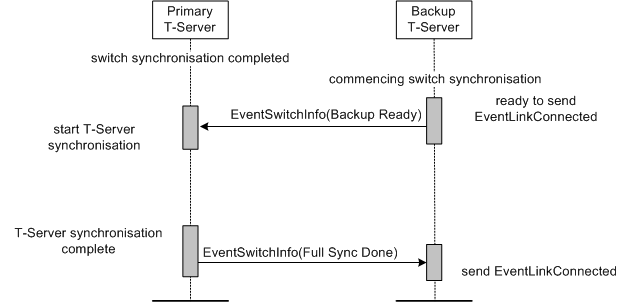Hot-Standby HA
Contents
- 1 Hot-Standby HA
- 1.1 If the Primary T-Server is Still in the Start-up Phase
- 1.2 If the Primary T-Server's Link with the Switch is Down
- 1.3 If the Backup T-Server Fails During Synchronization
- 1.4 If the Primary T-Server Fails During Synchronization
- 1.5 Call Synchronization Between T-Servers
- 1.6 Using the EventSwitchInfo Event
- 1.7 If the Backup T-Server Sends a EventSwitchInfo Message
- 1.8 If the Primary T-Server Sends a EventSwitchInfo Message
This section describes how T-Server supports the hot-standby high-availability (HA) synchronization.
The following figure shows the process of a successful detection of T-Server synchronization. The primary T-Server is assumed to have successfully completed the switch synchronization.
If the Primary T-Server is Still in the Start-up Phase
If the primary T-Server is still in the process of switch synchronization when it receives a Backup Readymessage from the backup T-Server, the primary T-Server sends the Full Sync Done message immediately. This allows the backup T-Server to send an EventLinkConnected message and become available. The Management Layer then sets the backup T-Server as the new primary, and vice versa. Once the old primary T-Server finishes switch synchronization, it initiates T-Server synchronization with the new primary T-Server as shown in the table above.
If the Primary T-Server's Link with the Switch is Down
If the primary T-Server has lost communication with the switch when it receives a Backup Ready message from the other T-Server, it sends the Full Sync Done message immediately. It can be assumed to have lost synchronization with the switch itself and there is no guarantee that it will recover communication with the link, which the backup T-Server currently has.
If the Backup T-Server Fails During Synchronization
If the backup T-Server fails while waiting for synchronization, the primary T-Server stops the synchronization process.
If the Primary T-Server Fails During Synchronization
If the primary T-Server fails while waiting for synchronization, the backup T-Server immediately sends an EventLinkConnected message.
Call Synchronization Between T-Servers
An integral part of T-Server synchronization is the synchronization of the Connection IDs of the calls between T-Servers. It is the Connection IDs of calls created by the backup T-Server during the switch synchronization phase that differ from those in the primary T-Server—those created afterwards are synchronized by the normal HA mechanism. When the primary T-Server receives the Backup Ready message from the backup T-Server, it tags all current calls. Once all tagged calls have been released, the primary T-Server can be certain that the Connection IDs for all current calls have been synchronized with the backup T-Server because they were created after the backup T-Server completed its startup phase. If no further T-Server synchronization is required, the primary T-Server sends the Full Sync Done message to the backup T-Server.
Using the EventSwitchInfo Event
T-Servers use the HA synchronization EventSwitchInfo messages for T-Server synchronization during the start-up phase of the backup T-Server. A new message attribute is defined to identify certain EventSwitchInfo events as specific only for backup synchronization. Two further attributes are required to distinguish between the Backup Ready event by the backup and the Full Sync Done event sent by the primary.
If the Backup T-Server Sends a EventSwitchInfo Message
The backup T-Server sends an EventSwitchInfo message to the primary T-Server indicating that it will become available as soon as the primary T-Server notifies it that the full synchronization is complete.
The backup T-Server sends a Standard level message to Message Server. This provides an indication that the backup T-Server is available for a forced fail-over (by stopping the primary) should this be needed. The format for the message is as follows, no parameters are required:
Backup T-Server is now ready, starting wait for full synchronization.
If the Primary T-Server Sends a EventSwitchInfo Message
The primary T-Server sends an EventUserEvent message to the backup T-Server once it has completed the full synchronization. Once the backup T-Server receives the event from the primary T-Server, it sends an EventLinkConnected message and becomes available for a managed fail-over.
The primary T-Server sends a Standard level message to Message Server. This provides an indication that it is completely safe to fail-over to the backup T-Server in situations where the EventLinkConnected message is sent immediately by the backup T-Server. The format for the message is as follows, no parameters are required:
Primary T-Server has detected full synchronization of backup T-Server.

